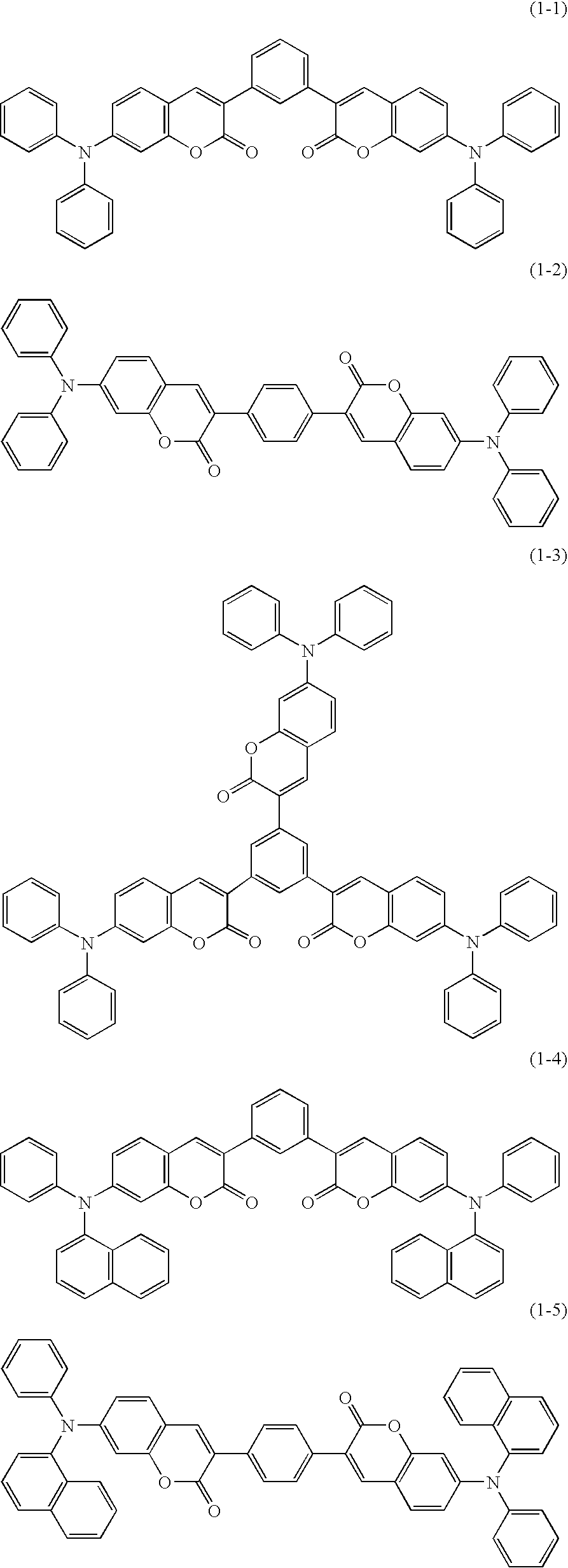Coumarin compound, material for light emitting device and organic electroluminescent device
a technology of organic electroluminescent devices and compounds, which is applied in the direction of discharge tube luminescnet screens, other domestic articles, organic chemistry, etc., can solve the problems of low luminous efficiency and large driving voltage of the device, and achieve the effects of reducing driving voltage, elongating the device life, and high luminous efficiency
- Summary
- Abstract
- Description
- Claims
- Application Information
AI Technical Summary
Benefits of technology
Problems solved by technology
Method used
Image
Examples
example 1
[0175]ITO was deposited on a glass substrate in a thickness of 150 nm to prepare a transparent supporting substrate. This transparent supporting substrate was fixed on a substrate holder of a commercial deposition equipment, and loaded therein were a molybdenum-made boat for deposition containing “CuPc”, a molybdenum-made boat for deposition containing “NPD”, a molybdenum-made boat for deposition containing “BH”, a molybdenum-made boat for deposition containing “BD”, a molybdenum-made boat for deposition containing “ETM1”, a molybdenum-made boat for deposition containing lithium fluoride and a tungsten-made boat for deposition containing aluminum.
[0176]The respective layers described below were formed in order on the ITO film of the transparent supporting substrate. A vacuum chamber was reduced in pressure up to 1×10−3 Pa, and the boat for deposition containing “CuPc” was first heated to deposit it in a layer thickness of 20 nm, whereby a hole injection layer was formed. Then, the b...
example 2
[0181]An organic electroluminescent device was obtained in the same manner as in Example 1, except that “ETM2” was used in place of “ETM1” which was the electron transport layer material used in Example 1. With the ITO electrode set to an anode and the lithium fluoride / aluminum electrode set to a cathode, the characteristics were measured at a current density set to 10 mA / cm2 to find that the voltage was 3.95 (V); the luminance was 870 (cd / m2); the luminous efficiency was 6.92 (Lm / W); and the life observed until an initial luminance of 1000 cd / m2 was reduced by half was 600 hours.
example 3
[0183]An organic electroluminescent device was obtained in the same manner as in Example 1, except that “ETM3” was used in place of “ETM1” which was the electron transport layer material used in Example 1. With the ITO electrode set to an anode and the lithium fluoride / aluminum electrode set to a cathode, the characteristics were measured at a current density set to 10 mA / cm2 to find that the voltage was 7.00 (V); the luminance was 635 (cd / m2); the luminous efficiency was 2.85 (Lm / W); and the life observed until an initial luminance of 1000 cd / m2 was reduced by half was 130 hours.
PUM
| Property | Measurement | Unit |
|---|---|---|
| valence | aaaaa | aaaaa |
| organic | aaaaa | aaaaa |
| luminous efficiency | aaaaa | aaaaa |
Abstract
Description
Claims
Application Information
 Login to View More
Login to View More - R&D
- Intellectual Property
- Life Sciences
- Materials
- Tech Scout
- Unparalleled Data Quality
- Higher Quality Content
- 60% Fewer Hallucinations
Browse by: Latest US Patents, China's latest patents, Technical Efficacy Thesaurus, Application Domain, Technology Topic, Popular Technical Reports.
© 2025 PatSnap. All rights reserved.Legal|Privacy policy|Modern Slavery Act Transparency Statement|Sitemap|About US| Contact US: help@patsnap.com



